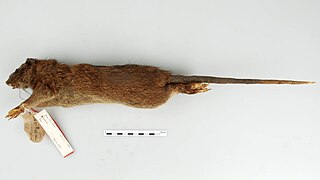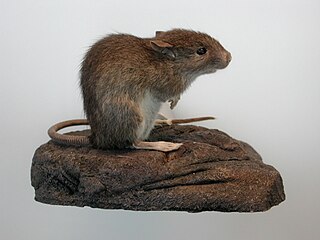
Rattus is a genus of muroid rodents, all typically called rats. However, the term rat can also be applied to rodent species outside of this genus.

The Flores giant rat is a rodent of the family Muridae that occurs on the island of Flores in Indonesia. It has been recorded in Rutong Protection Forest. The species is found in primary, secondary and disturbed forest over a wide range of elevations. Its head and body length is 41–45 cm (16–17.5 in) and its tail length is 33–70 cm (13–27.5 in). These dimensions are about twice as large as those of a typical brown rat, which suggests about eight times the body mass.

The Old World rats and mice, part of the subfamily Murinae in the family Muridae, comprise at least 519 species. Members of this subfamily are called murines. In terms of species richness, this subfamily is larger than all mammal families except the Cricetidae and Muridae, and is larger than all mammal orders except the bats and the remainder of the rodents.

The rakali, also known as the rabe, the "Australian Otter" or water-rat, is an Australian native rodent first scientifically described in 1804. Adoption of the Ngarrindjeri name rakali is intended to foster a positive public attitude by Environment Australia.
The earless water rat is a New Guinea rodent, part of the Hydromys group of the subfamily of Old World rats and mice (Murinae). It is the only species in the genus Crossomys. This species is probably most closely related to Baiyankamys. It is still unclear to which species this group is related. It is one of the most aquatically adapted rodents of the world.

Leptomys is a genus of rodent endemic to New Guinea. It is considered part of the New Guinea Old Endemics, meaning it was part of the first wave of murine rodents to colonize the island. Leptomys are seen to have minimal adaptations to their aquatic life style. Elongated hind feet accompanied by elongated centre toes suggest the ability to leap. The third molar which is lost is many rodents is retained, albeit smaller. Small eyes and ears can be seen amongst its velvety soft fur.

The fauna of New Guinea comprises a large number of species of mammals, reptiles, birds, fish, invertebrates and amphibians.

Hydromys is a genus of semiaquatic rodents in the subfamily Murinae. Three species are endemic to New Guinea and nearby islands. The fourth species, the rakali, is also found on Australia. The most recently discovered member of this genus was described in 2005.
Water rat(s) may refer to:

The Luzon montane forest mouse is a species of rodent in the family Muridae, from the genus Apomys. It occurs only in the Philippines, where it has been found on the large northern island Luzon. It is most closely related to the large Mindoro forest mouse, which occurs on Mindoro. There may be another related species in the Sierra Madre, but this species is yet undescribed. The Luzon montane forest mouse is a relatively large, ground-dwelling rat with a tail that is quite short for its genus.
The mountain water rat is a semiaquatic species of rodent in the family Muridae. It is found in West Papua, Indonesia and Papua New Guinea. Its natural habitat is rivers.
Shaw Mayer's water rat is a semiaquatic species of rodent in the family Muridae. It is found in the mountains of Papua New Guinea.
Rattus hainaldi is a species of rodent in the family Muridae. It is found only on Flores Island in Indonesia, including on Mount Ranaka. Part of its habitat is protected within the Kelimutu National Park. It is a small sized-species, with a body mass of around 40–100 grams (1.4–3.5 oz), and is thought to be terrestrial and a nest builder that prefers closed, forested, montane habitats.

The New Guinean rat is a species of rodent in the family Muridae. It is found only in parts of central Papua New Guinea.
The large New Guinea spiny rat is a species of rodent in the family Muridae. It is found in Indonesia, Papua New Guinea, and the Solomon Islands.

Noronhomys vespuccii, also known as Vespucci's rodent, is an extinct rat species from the islands of Fernando de Noronha off northeastern Brazil. Italian explorer Amerigo Vespucci may have seen it on a visit to Fernando de Noronha in 1503, but it subsequently became extinct, perhaps because of the exotic rats and mice introduced by the first explorers of the island. Numerous but fragmentary fossil remains of the animal, of uncertain but probably Holocene age, were discovered in 1973 and described in 1999.

The Central Range montane rain forests is a tropical moist forest ecoregion on the island of New Guinea. The ecoregion covers the Central Range of the New Guinea Highlands, which extends along the spine of the island. The montane rain forests of the ecoregion are distinct from the surrounding lowland forests, and are home to many endemic plants and animals.
Rodents of the superfamily Muroidea, which includes mice, rats, voles, hamsters, bamboo rats, and many other species, generally have three molars in each quadrant of the jaws. A few of the oldest species retain the fourth upper premolar, and some living species have lost the third and even the second molars. Features of the molar crown are often used in muroid taxonomy, and many different systems have been proposed to name these features.

The northern voalavo, also known as the naked-tailed voalavo or simply the voalavo, is a rodent in the family Nesomyidae found in the Northern Highlands of Madagascar. Discovered in 1994 and formally described in 1998, it is the type species of the genus Voalavo; its closest relative is the eastern voalavo of the Central Highlands. DNA sequencing suggests that it may be more closely related to Grandidier's tufted-tailed rat than to other species of the closely related genus Eliurus. The northern voalavo is found at 1,250 to 1,950 m above sea level in montane wet and dry forests in the Marojejy and Anjanaharibe-Sud massifs. Nocturnal and solitary, it lives mainly on the ground, but it can climb and probably eats plant matter. Despite having a small range, the species is classified as being of least concern because it lacks obvious threats and much of its range is within protected areas.

Hydromyini is a very large, diverse tribe of muroid rodents in the subfamily Murinae. They are the dominant native rodents in Australasia and one of only two native rodent groups there, the other being the R. fuscipes group of the genus Rattus in the tribe Rattini. They are also found in parts of Southeast Asia.












